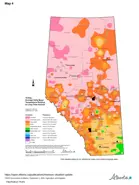Moisture Update - September 3, 2025
Precipitation
Map 1, 2 & 3: Over the last two weeks of August, less than 0.5 mm of precipitation fell across most of Alberta’s agricultural areas (Maps 1 and 2). This lower rainfall is favourable, as most crops have matured and harvest operations are well underway.
In the South Region, counties including Cypress, Forty Mile, Warner, Cardston, Willow Creek, Newell, and Foothills, received between 3 and 10 mm of rain in the last week (Maps 1 and 2), which is typical for this time of year (Map 3). A localized area within Cypress and Forty Mile Counties received between 10 and 25 mm.
Across the Central and the North West Regions, precipitation was minimal and below seasonal norms (Map 3). Small amounts of precipitation, ranging from 1 to 10 mm, were recorded in municipalities such as Yellowhead, Clearwater, Rocky View, Red Deer, Kneehill, Special Area No. 4, Provost, Paintearth, and Flagstaff (Maps 1 and 2).
In the North East and northern Peace Regions, rainfall ranged from 2 to 10 mm over the past two weeks, below the long-term average (Maps 1, 2, and 3). Virtually no precipitation was recorded in the central and southern Peace Region (Maps 1 and 2), where the long-term average is typically between 20 to 25 mm (Map 3).

Temperature
Map 4 : Over the last two weeks of August, average daily mean temperatures across the province ranged from moderately warm in the South Region to extremely warm in the Peace Region, relative to the long-term normal. These warmer conditions are expected to accelerate crop maturity. However, the impact on crop water demand will be minimal, as most crops have already matured and are no longer actively transpiring.
Growing Season Trends
Maps 5 & 6: Due to limited rainfall over the reporting period, growing season precipitation accumulations have declined slightly in many areas of Alberta, relative to the long-term normal (Map 5).
Despite this decline, precipitation remains near normal across much of the South, Central, and North West Regions (Map 5). However, the extent of areas with moderately above-normal precipitation, particularly within Yellowhead, Rocky View, Foothills, Wheatland, Newell, and Special Areas No. 2 and No. 3, has decreased compared to the previous report.
Parts of Forty Mile, Cypress, Clearwater, Mountain View, Red Deer, and Ponoka Counties are experiencing moderately low growing season precipitation, with cumulative totals now ranging from 70% to 90% of the long-term average (Map 6).
In northern Alberta, growing season precipitation remains moderately to extremely low (Map 5), especially north of a line extending through the municipalities of Provost, Flagstaff, Camrose, Ponoka, Leduc, and Parkland, and westward into Woodlands and Greenview. Most of these areas have received only 50% to 70% of their long-term average precipitation (Map 6).
Conditions are even more severe in the North East and Peace Regions, where growing season precipitation has declined to very low and extremely low levels (Map 5). Most areas have received just 50% to 70% of the long-term average (Map 6), with a corridor through Grande Prairie, Spirit River, Birch Hills, Smoky River, and Big Lakes municipalities showing departures as low as 30% to 50% of normal.
Soil Moisture Reserves
Maps 7, 8 & 9: Due to lower precipitation over the reporting period, soil moisture reserves have declined across much of Alberta, relative to long-term normal (Map 7). A few municipalities in the North West, Central, and South Regions are estimated to have near normal to moderately higher soil moisture reserves relative to long-term normal.
North of a line running through the municipalities of Mountain View, Kneehill, Starland, and Special Areas No. 2 and No. 3, soil moisture reserves are now estimated to be moderately to very low for this time of year (Map 7).
Extremely low to driest soil moisture reserve conditions have emerged in several municipalities, including Red Deer, Lacombe, Ponoka, Grande Prairie, Saddle Hills, Big Lakes, Northern Sunrise, Clear Hills, Lac La Biche, Athabasca, Special Areas No. 4, and Northern Lights (Map 7). This marks a deterioration from the moderately low levels reported previously.
Across most of the province, plant available water in the soil is estimated to be less than 40 mm (Map 8). Representing a moisture departure of 15 to 75 mm compared to normal levels (Map 9). However, a few localized areas along the foothills and around Swan Hills continue to maintain higher soil moisture reserves, with estimates exceeding 60 mm to a depth of 120 cm (Map 8).
Perspective
As of September 3, areas south of a line running from the M.D. of Provost through Flagstaff and Red Deer, and north through Parkland, Woodlands, and Greenview Counties, have received near-normal growing season precipitation, relative to long-term averages. Although conditions have declined due to the lack of rainfall over the reporting period, most of the South Region, and parts of the Central and North West Regions, continue to experience normal to above-normal precipitation accumulations. These areas are also seeing moderately warm to warm average daily mean temperatures compared to the long-term normal. However, exceptions remain in portions of Cypress County, where growing season precipitation continues to be moderately lower relative to long term normal.
In contrast, municipalities north of this line are experiencing moderately to very low growing season precipitation, along with warm to very warm average daily mean temperatures, relative to long-term normal.
As the growing season winds down and harvest progresses, water use by annual and perennial crops will diminish and eventually cease. If warm temperatures persist and ground cover is removed, soil evaporation may increase. Any additional precipitation will help begin the process of replenishing soil moisture reserves, beneficial for fall-seeded crops and early 2026 season growth.
Contact Us
Saddle Hills
Junction of Hwy 49 & Secondary Hwy 725
RR1, Spirit River AB
T0H 3G0
T. 780-864-3760
Fax 780-864-3904
Toll-free 1-888-864-3760
frontdesk@saddlehills.ab.ca
Sign up to our Newsletter
Stay up to date on the Saddle Hills activities, events, programs and operations by subscribing to our eNewsletters.








